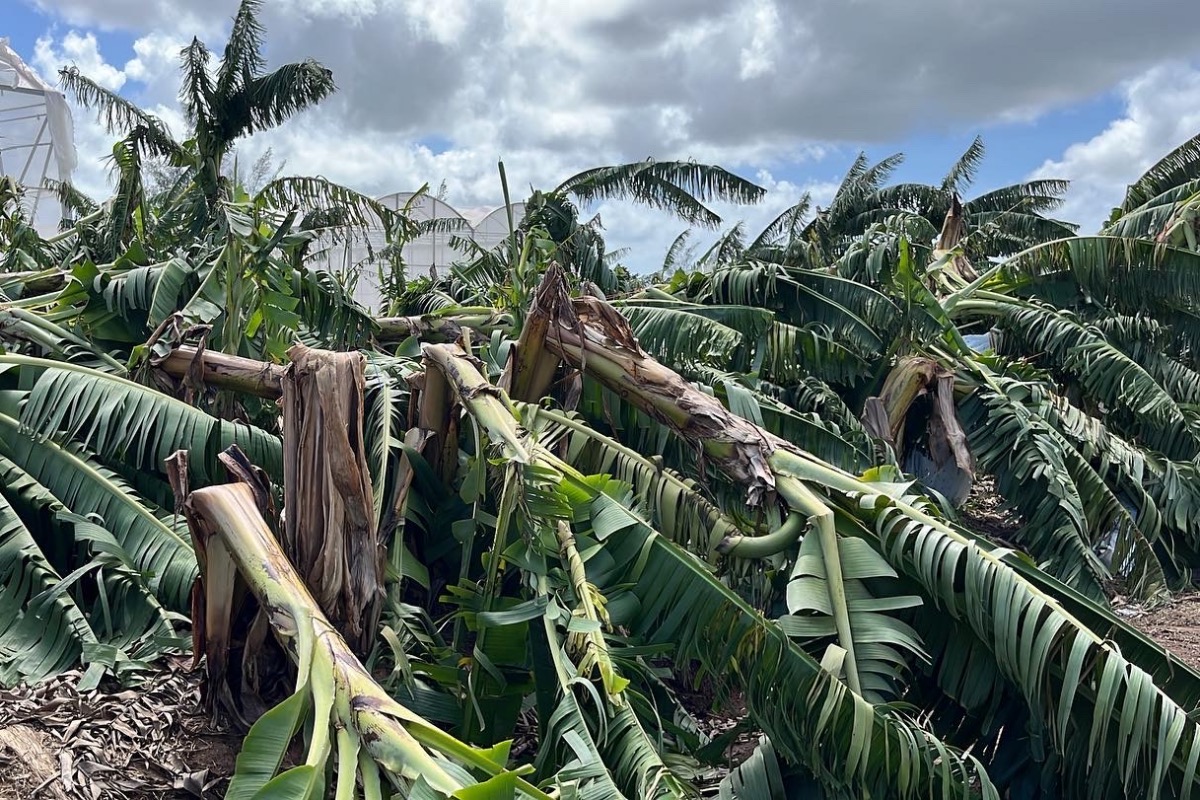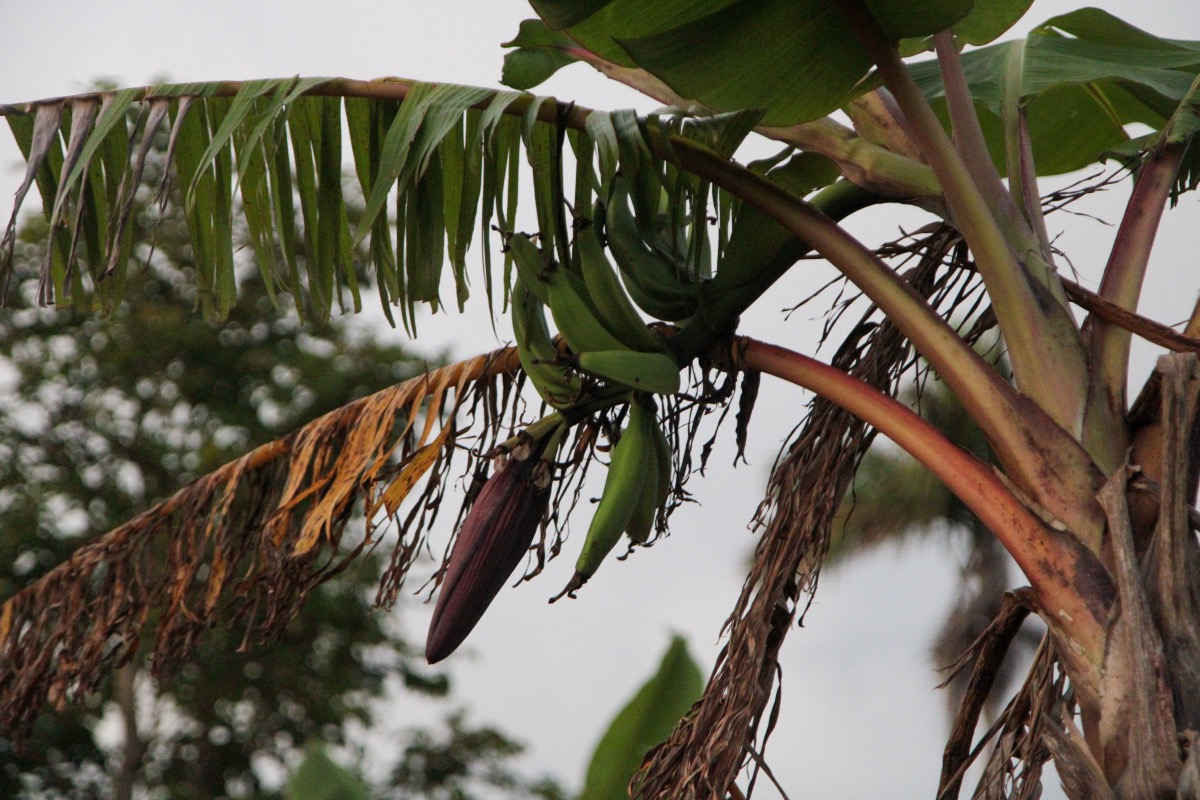

The plantain trees at Fabre Farms are completely destroyed in the wake of Hurricane Fiona, Sabana Grande, Puerto Rico. (Carlos Edill Berríos Polanco/Latino Rebels)
SAN JUAN — Puerto Ricans will likely spend this Christmas without their time-honored tradition of eating plantains with dinner, after Hurricane Fiona destroyed 80 percent of the island’s plantain and banana crops in September. And with climate change causing an increase in such extreme weather events across the Caribbean, having a full Christmas dinner in Puerto Rico may be off the table for the foreseeable future.
Over the past four years, Puerto Ricans have experienced an unceasing barrage of hurricanes, floods, landslides, and earthquakes. The most impactful were Hurricanes Irma and María, two Category 5 hurricanes that caused more than 4,500 deaths, $95 billion in damages, and caused the already fragile electrical grid to collapse entirely.
The most recent, Hurricane Fiona, caused record-setting flooding in many areas of Puerto Rico, destroying plantain crops in the south of the archipelago.
“There’s going to be a small shortage,” Jose Javier Fabre, who handles distribution for his family company Fabre Farms, told Latino Rebels right after Fiona swept through. The farm lost its entire avocado crop and about 95 percent of its plantain and banana plants.
Fabre prediction of a shortage is now a reality, except that the shortage is much larger than he estimated. The shortage has racked both restaurants and home kitchens islandwide. Most of the plantains available for purchase today come frozen in bags or are from the few plantain trees that survived the floods.
For Ada Ramona Miranda Alvarado, who runs Hacienda Las Malcriá in Adjuntas, the surge in storms has been especially devastating. Before Fiona, Hurricane Isaias in 2020 destroyed nearly 75 percent of her plantain crop.
Hurricane Fiona destroyed 90 percent of plantain and banana trees on the farm, which has had a two-fold effect: not only does she not have any to sell, but the plantain and banana trees provided shade for her coffee plants. Miranda Alvarado cultivates a special type of traditional coffee that grows in the shade. But without any shade, barely any of the 300 coffee trees she’s planted have grown.
The storms not only cause the immediate destruction of crops but also make working the land much harder, due to the water-soaked terrain and ensuing rainfall that follows a storm for weeks.
“The rain has affected us completely,” Miranda Alvarado told Latino Rebels at the Central Aguirre Artisan Fair southern municipality of Salinas. “We can’t harvest. We go to the ranch, we get wet, and spend the entire time working while we’re soaked.”
Coffee is one of the most popular crops in Puerto Rico, and also one of the most affected by extreme flooding. But unlike plantains and bananas, Puerto Rico imports a lot of coffee.
“If we don’t look for a value add for this (coffee), I can’t do it with this,” Miranda Alvarado says. “I can’t live off of this.”
While none of the small coffee trees she brought to the fair have sold, a partnership with a local artisan has been a boon for her during these tough times. The artisan uses the coffee beans that are not good enough to sell to make beaded necklaces and wristbands. Miranda Alvarado says that they, along with some oranges, yucca, cocoyam, and what little plantains she had left have been selling fairly well, but the struggle to grow gets harder each time there is intense flooding.
No Homegrown Food on a Flooding Island
Puerto Rico is five times more likely to be struck by extreme rainfall today than it was decades ago. Given that the archipelago is uniquely susceptible to flooding and its location on the eastern edge of the Greater Antilles, Puerto Rico is one of the most vulnerable places in the world to the effects of climate change, alongside other Caribbean nations. Extreme atmospheric events such as the flooding experienced with Fiona or the disastrous winds that came with María are only becoming more common, which “cause more and more damage to the agriculture sector” and aggravate the food insecurity of countries they hit, according to the Food and Agriculture Organization of the United Nations.
In the last weeks alone, there have been half a dozen flood warnings issued for multiple municipalities across the archipelago due to heavy rains. Some areas experience repeated flooding that makes growing any food there a herculean task.
In one video captured by Latino Rebels, a plantain field in the east-central part of the island is submerged in floodwaters up to the leaves—at least five feet up from where the nearby river typically stands.
Another angle w/ commentary pic.twitter.com/Y3C48yqYLD
— carlos berrios polanco (gonzo futurist era) (@Vaquero2XL) September 18, 2022
As history has shown, climate change will hit the hardest in places that already suffer severe inequalities, such as Africa, Asia, and Latin America. The effects of climate change continue to compound in these already heavily affected areas, causing rising hunger rates and poverty. It is estimated that climate change-induced damages would cost Latin America and the Caribbean an estimated $462 billion by 2050 and up to $891 billion by 2070.
Historically, countries in the developing world, like Puerto Rico and its Caribbean neighbors, have and will continue to receive the brunt of the effects of climate change while contributing relatively little to its causes. The United States is responsible for the largest share of historical emissions, while China is currently the largest emitter of greenhouse gases in the world.
This inequality between high-emission countries and low-emission countries necessitates a move towards climate justice, where those who have done the most damage to the planet attempt to help those who will suffer the most. In fact, the 2022 United Nations Climate Change Conference in Egypt closed earlier this month with the decision to set up a new “loss and damage fund” for those on the “frontlines of the climate crisis,” whose structure should be defined at next year’s climate conference in Dubai.
Latin American and Caribbean action was fundamental to agreement reached in Egypt. While the fund is a historic deal to help climate victims, it does little to stop the main economical and political forces that produce climate change, and it must be fully and effectively implemented to advance climate justice.
Towards Climate Adaptation
The U.S. Department of Agriculture ordered plantains and bananas from Ecuador, Costa Rica, and the Dominican Republic to make up for the plantain shortage in Puerto Rico. Due to shipping issues between countries, however, the plantains have been delayed multiple times, with Agriculture Secretary Ramón González Beiró saying the first shipment could be delayed into late December. Some remain hopeful that the shipments will arrive by the second or third week at the latest—early enough to enjoy the traditional tostones or amarillitos alongside lechón for the holidays.
Latino Rebels reached out to the Department of Agriculture did not receive a response to our phone calls.
For now, it is likely that at least some Puerto Ricans will be plantain-less for the holidays, but a future looms in which the archipelago is entirely without its favorite fruits should global temperatures continue to rise at their current rate.


Plaintains at Hacienda Las Malcriá in Adjuntas, Puerto Rico. (Carlos Edill Berríos Polanco/Latino Rebels)
Puerto Rico only grows somewhere between 15 and 20 percent of the food its citizens eat, mostly the aforementioned plantain and bananas, but also yucca, coffee, and sugar cane. Hurricane Fiona devastated an estimated 80 percent of the island’s crops —including 60 percent of the coffee crop— totaling more than $780 million in damages.
The archipelago’s lack of food production has forced it to import the majority of its food, which agriculturists say has long created a problem of food insecurity. But it was not always so. Agriculture was once one of the main drivers of the island’s economy, until U.S. mandates pushed a pivot toward industrialization.
Miranda Alvarado says the answer to the growing food insecurity and the possibility of not being able to grow traditional crops is changing a bit of what Puerto Ricans consume, how foods are harvested, and adopting regenerative agriculture.
Part of this adaptation involves not holding hard and fast to what has been typically grown in a certain season. Traditionally, plantains and bananas are planted throughout the year, but Miranda Alvarado says that farmers need to focus on fruits and vegetables that are not as heavily impacted by the floods and strong winds of hurricane season.
She points to two of the main tropical root vegetables —yucca and cocoyam—which grow underground. “I tell people ‘You know what? We don’t have plantains but we have yucca, taro, and cocoyam,'” Miranda Alvarado says. “You can get these from under the earth. It’s a type of harvest that you already have there. You don’t have the blessed mofongo, then make a blessed mofongo out of yucca.”
Part of the adaptation, Miranda Alvarado explains, is returning to harvesting methods that do not exploit the land and seek continuous growth since resources, like rich topsoil, eventually erode after nonstop use. Miranda Alvarado wants to use agricultural practices that her mother and grandmother used that don’t necessitate such destructive use of the land, but instead work within the confines of what the ever-changing climate allows.
“All this regeneration depends on agriculturists being open to new (farming) practices that are being used now that have already been in use for a long time,” she said.
By all accounts, homegrown plantains, bananas, and coffee won’t be back on the market in any meaningful way until the summer of next year. What cannot wait is climate action to ensure the future of the Caribbean islands.
—
This story was published with the support of the Caribbean Climate Justice Journalism Fellowship, which is a joint venture of Climate Tracker and Open Society Foundations.
***
Carlos Edill Berríos Polanco is the Caribbean correspondent for Latino Rebels, based in San Juan, Puerto Rico. Twitter: @Vaquero2XL



[…] story was originally published by Latino Rebels, with the support of the Caribbean Climate Justice Journalism Fellowship, which is a joint venture […]
[…] story was originally published by Latino Rebels, with the support of the Caribbean Climate Justice Journalism Fellowship, which is a joint venture […]
[…] story was originally published by Latino Rebels, with the support of the Caribbean Climate Justice Journalism Fellowship, which is a joint venture […]
[…] story was originally published by Latino Rebels, with the support of the Caribbean Climate Justice Journalism Fellowship, which is a joint venture […]
[…] story was originally published by Latino Rebels, with the support of the Caribbean Climate Justice Journalism Fellowship, which is a joint venture […]